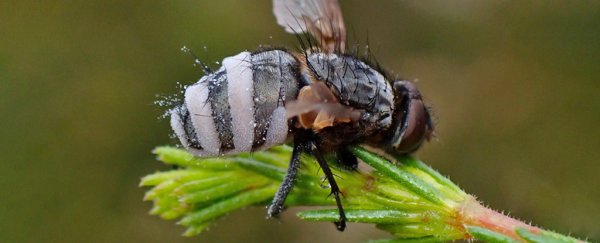The parasitic fungus Entomophthora muscae goes to great lengths to exploit the sexual urges of house flies. According to a recent study, after taking control of a fly's brain and sending its host to die on the highest point it can reach, the zombifying mold concocts a powerful aphrodisiac to complete its ruse.
This love potion fans the flames of lust in healthy male flies, encouraging them to put their moves on the opposite sex, dead or alive. Sometimes that means bloated female carcasses, literally bursting with spores.
The urge to reproduce drives so much in nature that it's an ideal target for hijacking. From plants that disguise their flowers as female insects to tempt males into doing their dirty pollen-carrying work, to fungi that trick male spiders into mating with infected females, many organisms tap into this power of lust.
After all, when two potential mates lock onto each other in blind attraction, decision-making skills can become… compromised.
The zombie fungus exploits this weakness to an astonishing level, and University of Copenhagen researchers conducted a series of experiments that conclusively demonstrate how. Their work is yet to be peer reviewed, but is available on the preprint server bioRxiv.
Ecologist Andreas Naundrup and team offered male flies a choice between infected and non-infected dead females within the same testing arena. While they found no clear difference between which carcass the male chose to mate with, there was a higher number of mating attempts with both remains, if one of the dead females was in the late stage of spore release (sporulation) phase of infection.
To confirm this boost in fly sexy times was indeed beneficial to the fungus, the researchers incubated the male flies for 10 days. Almost three quarters of males exposed to females with late stage sporulation became infected, compared to 15 percent of the males who tried to get busy with carcasses in the early sporulation stage.
Naundrup and colleagues then measured the male house fly antenna responses to volatile compounds surrounding living flies, uninfected cadavers, and sporulating cadavers. Again, dead sporulating females proved most attractive.
When comparing chemicals using gas chromatography and mass spectrometry of early sporulation stage, late sporulation stage, and uninfected flies, the team found a distinct chemical profile of long-chained alcohols and esters.
After testing these compounds on the flies, the researchers concluded that multiple types of these volatile chemicals appear to work together to attract the males.
"E. muscae induces changes in the volatile chemistry that attract house flies by both altering the levels of cuticular fly hydrocarbons and by producing several unusual volatile compounds," the team writes in their preprint paper.
Some of these compounds are unknown in house flies, but attractive in other insects like bumblebees. The researchers suspect that the more volatile chemicals may be a food attractant to lure from a distance, with the weaker signals tapping into the flies' reproductive urges.
Examining gene expression, the team also found E. muscae actively expressed key enzymes during late stage sporulation, known to produce these compounds.
While the fungal disease can rip through populations of house flies in an animal epidemic, it is not specific to this species and is known to infect other flies, like blowflies and hoverflies.
Once a spore has landed on a suitable host, it grows a root-like mycelium system that reaches into the part of the brain controlling the insect's crawling behavior. There it manipulates the fly to crawl up towards a better spore-releasing height, while eating its flesh from within and developing its own reproductive organs that burst out from the dead fly.
Not only does this fungus have the disturbing ability to zombify its host, it also has the incredible power to manipulate healthy flies it has yet to even touch. This example of chemical mimicry exploiting animal mating urges is one of the first descriptions of such extended behavior-manipulation by a pathogen, Naundrup and team explain.
"The findings presented here may thus have potential for the discovery of novel semiochemical house fly-specific attractants or pheromones that could be used in pest control," they suggest.
A parasite's dire need to spread itself sure can produce some truly depraved tactics.
This research can be found in preprint on bioRxiv.
